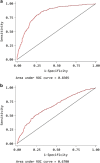Common polygenic variation in coeliac disease and confirmation of ZNF335 and NIFA as disease susceptibility loci
- PMID: 25920553
- PMCID: PMC4717209
- DOI: 10.1038/ejhg.2015.87
Common polygenic variation in coeliac disease and confirmation of ZNF335 and NIFA as disease susceptibility loci
Abstract
Coeliac disease (CD) is a chronic immune-mediated disease triggered by the ingestion of gluten. It has an estimated prevalence of approximately 1% in European populations. Specific HLA-DQA1 and HLA-DQB1 alleles are established coeliac susceptibility genes and are required for the presentation of gliadin to the immune system resulting in damage to the intestinal mucosa. In the largest association analysis of CD to date, 39 non-HLA risk loci were identified, 13 of which were new, in a sample of 12,014 individuals with CD and 12 228 controls using the Immunochip genotyping platform. Including the HLA, this brings the total number of known CD loci to 40. We have replicated this study in an independent Irish CD case-control population of 425 CD and 453 controls using the Immunochip platform. Using a binomial sign test, we show that the direction of the effects of previously described risk alleles were highly correlated with those reported in the Irish population, (P=2.2 × 10(-16)). Using the Polygene Risk Score (PRS) approach, we estimated that up to 35% of the genetic variance could be explained by loci present on the Immunochip (P=9 × 10(-75)). When this is limited to non-HLA loci, we explain a maximum of 4.5% of the genetic variance (P=3.6 × 10(-18)). Finally, we performed a meta-analysis of our data with the previous reports, identifying two further loci harbouring the ZNF335 and NIFA genes which now exceed genome-wide significance, taking the total number of CD susceptibility loci to 42.
Figures



References
-
- 1Abadie V, Sollid LM, Barreiro LB, Jabri B: Integration of genetic and immunological insights into a model of celiac disease pathogenesis. Ann Rev Immunol 2011; 29: 493–525. - PubMed
Publication types
MeSH terms
Substances
Grants and funding
LinkOut - more resources
Full Text Sources
Other Literature Sources
Medical
Molecular Biology Databases
Research Materials

